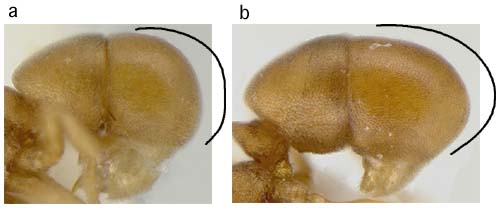
Figure 1. Abdominal segments 3 and 4 of (a) Discothyrea horni and (b) D. testacea.
Formicidae, Hymenoptera, Insecta, Arthropoda, Animalia
SEM images of worker, collection JTL1995-s, Monteverde, Costa Rica: whole worker lateral view (reduced, original); head, face view (reduced, original); head, lateral view (reduced, original); antenna (reduced, original); clypeus (reduced, original).
Range
Costa Rica (type locality). I have seen horni-like material from Colombia, Mexico (Chiapas and Veracruz), and Panama, but given the taxonomic uncertainty of species boundaries in Discothyrea, I am reluctant to make any statements about the range outside of Costa Rica. In Costa Rica this species occurs in wet to moist forests throughout the country, from near sea level to cloud forest at 1600m.
Identification
Antennae 8 segmented; interantennal lamella forming an obtuse angle between antennal insertions and descending to a somewhat projecting clypeal shelf, so that lamella appears rectangular in lateral view; anterior margin of interantennal lamella usually without a tooth above clypeal apron; in face view anterior margin of clypeus very shallowly convex to nearly flat; color dark red brown; HW about 0.4mm.
Similar species: D. denticulata, JTL-009.
Natural History
Discothyrea are extremely small, cryptobiotic inhabitatants of forest leaf litter (see Genus Overview).
Discothyrea horni is the most common species in Costa Rica. It occurs in a wide variety of habitats: lowland wet or dry forest and montane cloud forest. It is more abundant in montane and cloud forest than in lowland forest. Workers and queens are relatively common in Berlese and Winkler samples of soil and litter. I have never found a nest.
Type data
Discothyrea horni Menozzi 1927:270. Holotype queen: Costa Rica, San Jose (Schmidt) [DEIC] (examined).
Comments
I examined the type of horni in 1990. It matched the montane dark horni typical of Monteverde and Volcan Barva cloud forest. Much of Schmidt's material was collected in montane forests around San Jose, such as Vara Blanca.
Similar taxa: testacea
Discothyrea testacea Roger 1863:177. Syntype worker, queen: USA (possibly North or South Carolina, see Smith and Wing 1955).
Discothyrea horni is distinguished from D. testacea by the shape of abdominal tergite 4. In horni, it is evenly rounded in lateral profile and relatively hemispherical in shape (Figure 1a). In testacea, it is relatively more produced and pointed posteriorly, with a more parabolic shape in lateral profile (Figure 1b). Also, the North American testacea I have examined have a distinctly 9-segmented antenna. In nearly all the Costa Rican horni I have examined, the antennae are 8-segmented. (Counting the scape as segment 1, variation in antennal segment number occurs in the small funicular segments between segment 2 and the enlarged apical segment.)

Figure 1. Abdominal segments 3 and 4 of (a) Discothyrea horni and (b) D. testacea.
Literature Cited
Menozzi, C. 1927. Formiche raccolte dal Sig. H. Schmidt nei dintorni di San Jose di Costa Rica. Entomol. Mitt. 16:266-277.
Roger, J. 1863. Die neu aufgefuehrten Gattungen und Arten meines Formiciden-Verzeichnisses nebst Erganzung einiger frueher gegebenen Beschreibungen. Berl. Entomol. Z. 7:131-214.
Smith, M. R., and M. W. Wing 1955(1954). Redescription of Discothyrea testacea Roger, a little-known North American ant, with notes on the genus (Hymenoptera: Formicidae). Journal of the New York Entomological Society 62:105-112.
Page author:
John T. Longino, The Evergreen State College, Olympia WA 98505 USA.longinoj@evergreen.edu